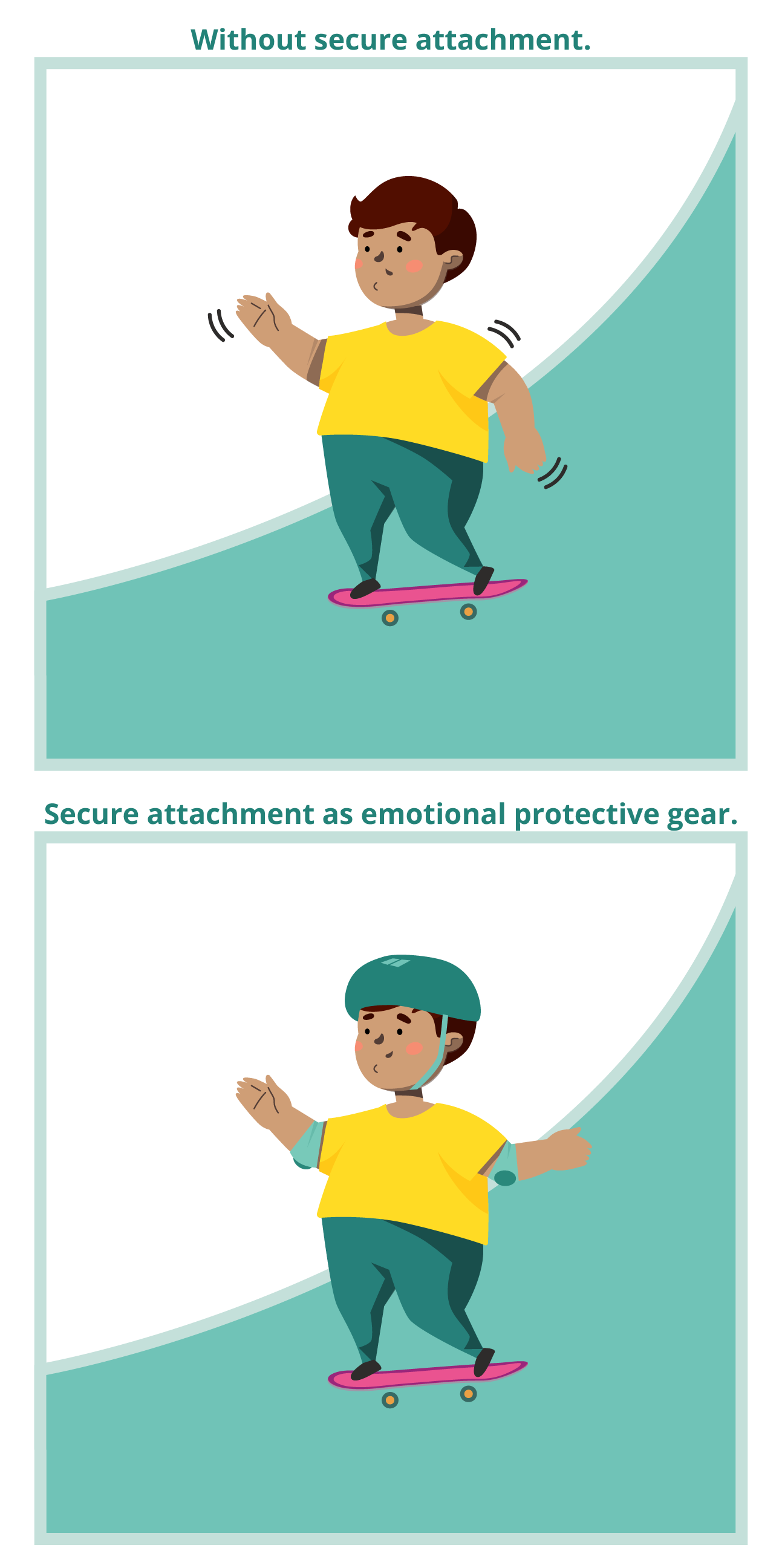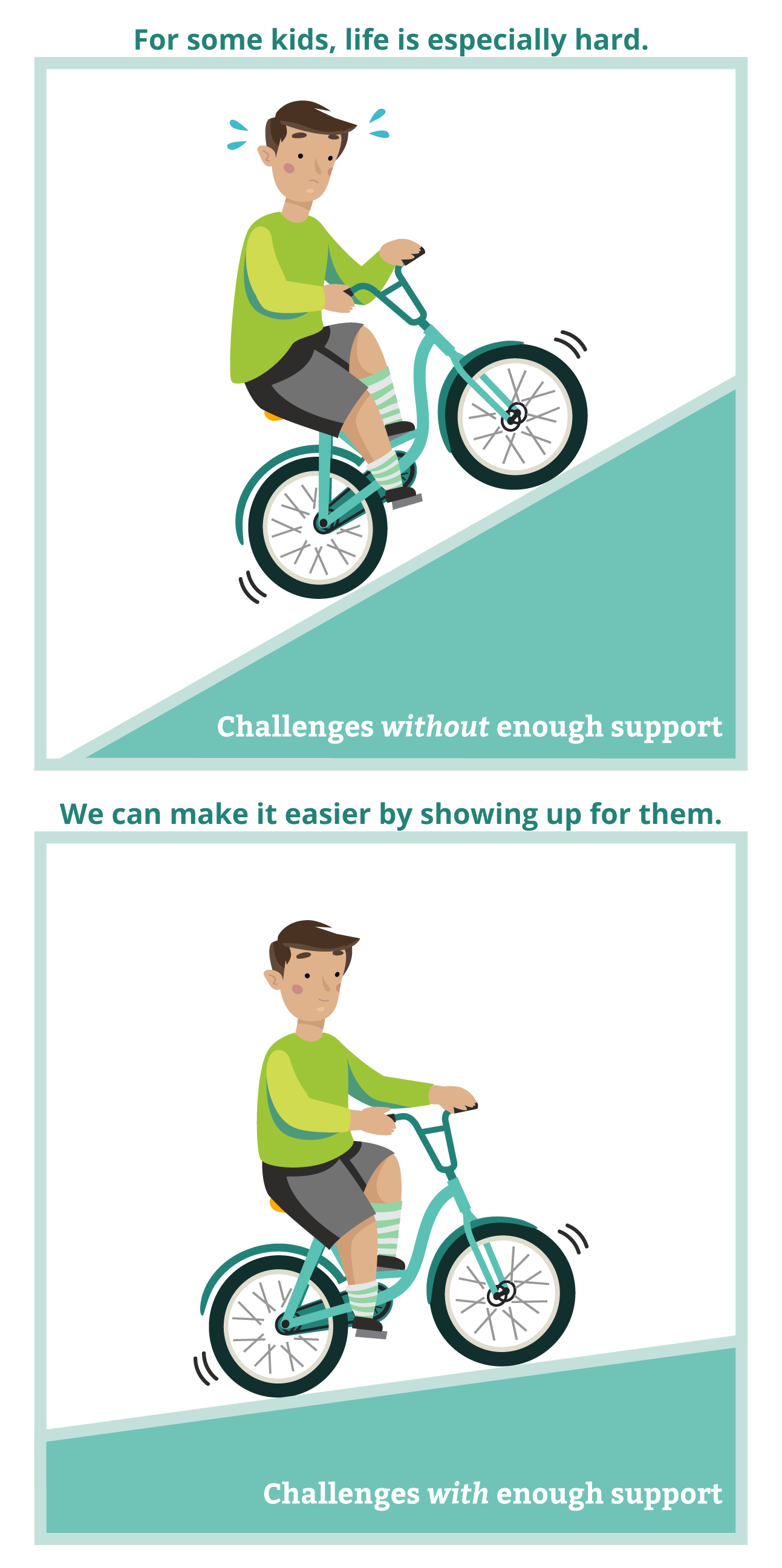Secure Attachment
Your greatest impact as a parent and caregiver begins right where you are. As caring adults, you come equipped with positive intentions for children in your home and you are hardwired to form a close and lasting attachment with them. A secure attachment is the most important foundation you can offer to children.
Attachment refers to a deep and enduring emotional bond that develops between a child and a primary caregiver. It refers to how babies rely on their caregivers to make them feel safe and secure as they grow toward maturity.
The central theme of attachment theory is that children grow and thrive in the context of close and consistently reliable relationships that allow them to develop a secure attachment. A secure attachment between a child and at least one adult helps to ensure that the neural pathways within the child’s brain become sculpted with the best possible connections made to handle stress, reduce anxiety and easily absorb new information and experiences. Developmental psychologist, Jude Cassidy defined a secure attachment as “confidence in the possibility of goodness”. A child with a secure attachment knows they can count on you, time and again, to be there for them. They carry that trust with them through important transitions and stages in life.
For a child, developing a secure attachment with at least one adult results in:
-
Better emotional regulation
-
Higher self-esteem
-
Greater willingness to explore
-
Greater academic success
-
Better problem-solving and coping skills
-
Better communication skills
-
More positive engagement with peers
-
A greater sense of self-agency
-
More trusting and meaningful relationships
-
More effective social interactions
-
More empathy
-
Stronger leadership qualities

Based on “The Power of Showing Up” by Daniel J. Siegel, M.D. and Tina Payne Bryson, PhD
Secure babies start life with a big advantage. A secure attachment is like an emotional protective gear on par with a helmet. Wearing a helmet won’t prevent an accident, but it will keep the child safe and protected should any accidents happen. Through a secure attachment, children can feel safe and cared for during tough experiences. With the trust that they can count on someone to help soothe the sting of life’s inevitable hardships, they gain the confidence they need to go out and find out who they are – and who they can become – in the big wide world.
Attachment can tip the balance in a child’s stress level, ability to manage emotional experience, capacity for learning, and overall health. The stress of unmet attachment needs can derail a child’s mental, emotional, social, and physical growth. The kind of stress that starts in infancy when the pressures of being a helpless newborn aren’t eased by a caregiver’s comfort is called “toxic stress”. Toxic stress creates pathways in the brain that keep the child on high alert for danger.
Children who have experienced trauma during their early years may constantly feel like they are pedalling a bicycle up a steep hill. As a caregiver, you may not be able to remove the force of gravity or flatten the hill, but if you can make them feel safe, seen, soothed and secure, you can at least regrade the slope so that pedalling isn’t quite so arduous.
Clinicians and founders of The Circle of Security, Kent Hoffman, Glen Cooper and Bert Powell, discovered that at the root of many struggles was the lack of a secure attachment in childhood. When no one had been there for them often enough as children, satisfying intimate relationships eluded them as adults. They wrestled with self-doubt and underachieved or overachieved at work. They suffer stress-related health problems or felt chronically dissatisfied with their lives and close relationships. A secure, trust-based emotional bond between a caregiver and a child holds the key to development. Every time you answer a child’s need for comfort or safety, you’re building a bond of trust that will result in a secure attachment.

Based on “The Power of Showing Up” by Daniel J. Siegel, M.D. and Tina Payne Bryson, PhD
What is attachment disorder?
Attachment disorder is a condition in which individuals have difficulty trusting anyone or creating meaningful and lasting relationships due to serious disruptions in forming attachments during early childhood.
Tips on developing an attachment with a child:
- Engage in serve and return interactions.
- Be predictable. Have a routine for meals, bedtime and other regular activities.
- Learn appropriate age-development skills and work with the child to master them.
- Play games with them.
- Read books to them.
- Encourage them to tell stories.
- Encourage the child to teach you something they learned at school.
- Be supportive in meeting their environmental needs (e.g. preferences in clothing, food, activities).
- Be consistent and responsive to their needs (e.g. respond quickly and empathetically when they are sick).
- Provide a quality of presence (e.g. attend school functions, get to know their friends, help them with homework).
- Take an attitude of curiosity rather than immediate judgment when they are having tantrums and meltdowns. Be calm and ask questions in order to understand what’s beneath their behaviour.
Quiz time!
Take this quick knowledge check about the importance of secure attachments in early childhood development.
References
Hoffman, K., Cooper, G., Powell, B., & Benton, C. M. (2017). Raising a secure child. Guilford Publications.
Powell, B., Cooper, G., Hoffman, K., & Marvin, R. S. (2009). The circle of security. In C. H. Zeanah, Jr. (Ed.), Handbook of infant mental health (pp. 450–467). The Guilford Press.
Powell, B., Cooper, G., Hoffman, K., & Marvin, R. S. (2009). The Circle of Security Intervention: Enhancing Attachment in Early Parent-Child Relationships. The Guilford Press.
MacNamara, D. (2016). Rest, Play, Grow: Making Sense of Preschoolers (Or Anyone Who Acts Like One). Vancouver, BC: Aona Management.
Neufeld, G., & Maté, G. (2004). Hold on to your kids: Why parents matter. Toronto: A.A. Knopf Canada.
Siegel, D. J., & Bryson, T. P. (2020). The power of showing up: How parental presence shapes who our kids become and how their brains get wired.
Siegel, D. J., & Bryson, P. H. D. T. P. (2012). The whole-brain child. Random House.
Woodhouse, S. S., Powell, B., Cooper, G., Hoffman, K., & Cassidy, J. (2018). The circle of security intervention: Design, research, and implementation. In H. Steele & M. Steele (Eds.), Handbook of attachment-based interventions (pp. 50–78). The Guilford Press.
Phone
Main:
604-544-1110
Toll-Free Foster Parent Line:
1-800-663-9999
Office hours: 8:30 am - 4:00 pm, Monday to Friday
PROVINCIAL CENTRALIZED SCREENING
Foster parents are encouraged to call this number in the event of an EMERGENCY or CRISIS occurring after regular office hours:
1-800-663-9122
REPORT CHILD ABUSE
If you think a child or youth under 19 years of age is being abused or neglected, you have the legal duty to report your concern to a child welfare worker. Phone 1-800-663-9122 at any time of the day or night. Visit the Government of BC website for more info.
address
BCFPA Provincial Office
Suite 208 - 20641 Logan Avenue
Langley, BC V3A 7R3
contact us
Fill out our contact form...

News
Site menu
Subscribe to Our Newsletter
Charitable Registration #
106778079 RR 0001
Our work takes place on the traditional and unceded Coast Salish territories of the Kwantlen, Katzie, Matsqui and Semiahmoo First Nations. BCFPA is committed to reconciliation with all Indigenous communities, and creating a space where we listen, learn and grow together.
© 2021 BC Foster Parents. Site design by Mighty Sparrow Design.